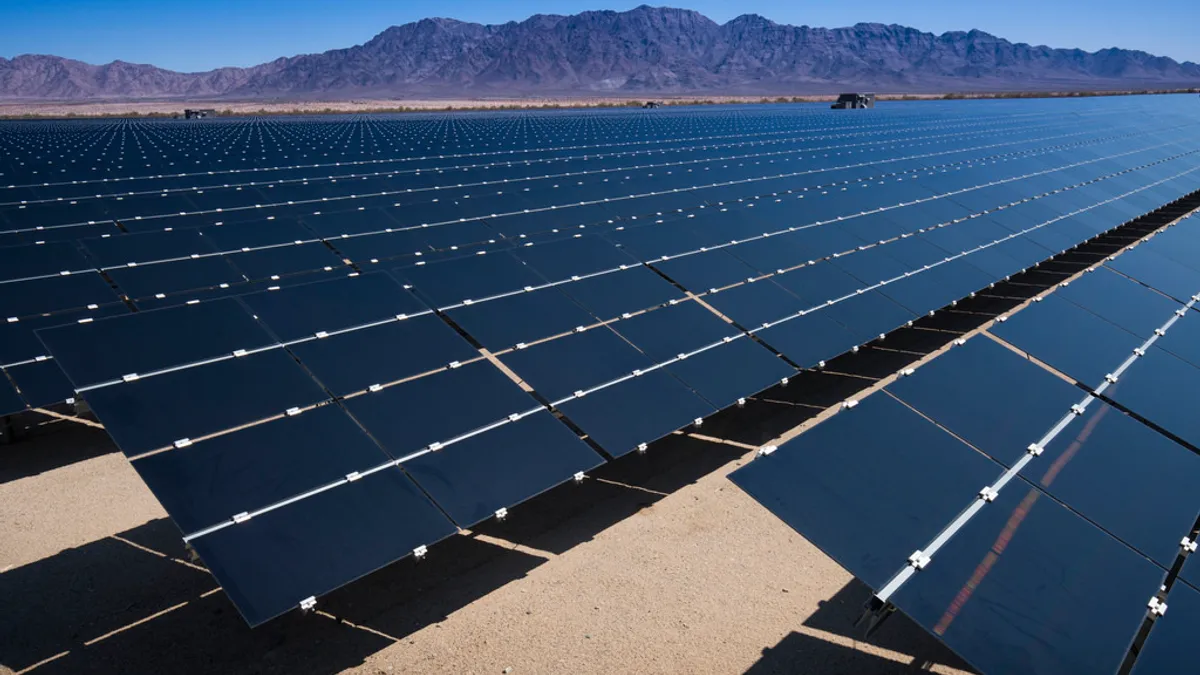The following is a contributed article by Sally Talberg, senior policy fellow at Public Sector Consultants and former chair of the Michigan Public Service Commission, in collaboration with the Ultra Low-Carbon Solar Alliance.
We don't typically have to think about supply chains. Packages almost magically appear at our doorstep with the click of a button, and grocery store shelves are usually full. But recent shortages of cars, electronics, paper and other products due to the global pandemic, shipping challenges and other factors disrupting the flow of goods around the world are now topics of dinner conversation.
Solar panels are also in high demand and are critical to mitigate climate change but have been particularly hard hit this year by supply chain problems. The solar industry is reeling with market disruptions over trade and logistics issues. Supply uncertainty and constraints are fueling cost increases and potential delays in solar projects — a major concern for utilities and other purchasers that rely on solar as the go-to resource for transitioning to clean energy.
This supply chain predicament didn't happen overnight and is complicated by trade relations with China, most notably a recent U.S. ban on solar panels containing certain raw material produced in China's Xinjiang region, based on evidence of forced labor that the People's Republic of China has not acknowledged. Under this withhold release order, U.S. Customs and Border Protection is inspecting and barring the release of some imported panels at the border. The challenging work of tracing components back to the raw materials to ensure products are free of these substances in turn makes it hard for developers to arrange for and price new solar projects.
Although the U.S. originally developed current solar technologies, China has put a strategy in place over the past 15 years to dominate solar manufacturing through trade and domestic manufacturing policies. Today, China controls most of the supply chain, including 96-98% of solar ingot and wafer production, which are both needed for solar panel production. The U.S. can produce substantial amounts of the polysilicon used to make ingots and wafers, but tariffs effectively block exports of U.S. polysilicon to China, limiting market access. China put these tariffs in place after the U.S. instituted antidumping and countervailing duties (AD/CVD), on Chinese solar cells and modules. In 2018, the U.S. added tariffs on imports of cells and modules from all countries to encourage U.S. manufacturing, and companies have filed a petition to extend these tariffs under Section 201 of the 1974 Trade Act. Additionally, a group of U.S. solar companies has asked the government to examine the Chinese AD/CVD, claiming that manufacturers are unfairly going around these orders by sending panels through Malaysia, Thailand and Vietnam. These “solar trade wars” fuel geopolitical tensions and market uncertainty but have done little to change our dependence on imports or the risks that come with them.
We're expecting staggering growth in demand for solar energy in the U.S. and worldwide in the upcoming decade, and we need to move quickly to reduce carbon emissions to avoid the worst effects of climate change. To support this growth and meet our clean energy goals, we need a resilient and sustainable solar supply chain that mitigates risk and keeps costs low over the long term. This requires proactive policies to harness new investment and expand the capacity to manufacture critical solar components at home.
First, we need federal policy to support U.S. manufacturing of vital solar components, like ingots and wafers. We have the manufacturing expertise and talent to compete with overseas producers, but investors need greater certainty given the volatile geopolitical environment. One approach, which would promote manufacturing at scale through a tax credit on U.S.-manufactured solar components, is the proposed Solar Energy Manufacturing for America Act pending in the U.S. Senate and House of Representatives. Other programs, such as the U.S. Treasury's 48C Advanced Energy Manufacturing investment tax credits, help support the initial capital investment in manufacturing. Not all manufacturing needs to or will be in the U.S., but we need to reshore critical aspects to diversify supply sources.
Second, utilities and their state regulators have an important role in bringing about a stable, more sustainable supply of solar. Utilities can mitigate risk and use their buying power to ensure solar technology is made with the right labor and environmental standards. In addition to the labor concerns, studies have shown that solar panels made in China have as much as two times the embodied carbon emissions as U.S.-produced solar panels because much of the manufacturing happens in regions dominated by coal-fired electricity generation. The Global Electronics Council is updating its Electronic Product Environmental Assessment Tool photovoltaics (EPEAT PV) standard to include embodied carbon criteria that will make it easier for utilities and corporate purchasers to include carbon content in bidding specifications. The updated EPEAT PV standard, which is expected next year, also includes broad sustainability criteria, including labor conditions. Utilities and other purchasers can drive change and lead on environmental, social and governance issues by sending clear demand signals through procurement standards like the EPEAT PV standard. Manufacturers will respond to that signal by locating new manufacturing in economies with lower carbon emissions.
Regulators might use broader criteria when evaluating utility proposals for new solar projects to consider both the bid prices and the benefits of a sustainable, transparent and resilient supply chain, such as mitigating price and supply risk and having lower overall carbon emissions. States like Michigan and New York are already taking such an approach, applying value-added criteria, such as job creation or brownfield property redevelopment, in bidding out solar projects. The path forward can be tailored based on state laws and the regulatory framework.
The significant challenges facing the solar industry could compromise efforts to accelerate clean energy deployment. Fortunately, there are tangible, near-term steps to build a sustainable and resilient solar supply chain while bolstering U.S. manufacturing jobs if policymakers, purchasers and manufacturers all do their part.






















